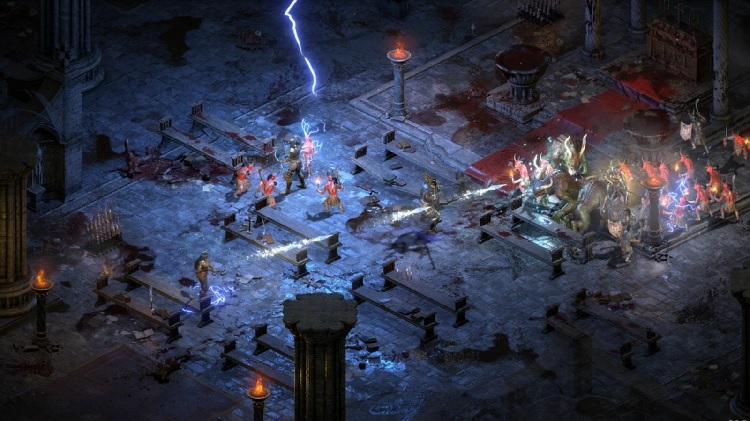Featured
How Has the Gaming Industry Evolved Over the Years?

Video games have been around for decades and have been one of the mainstream forms of entertainment ever since their inception. The retro games with pixelated graphics are a thing of the past now, and the video games are becoming more and more realistic as we speak. With Unreal Engine 5’s tech demo released on PS5, we can stay highly optimistic for the next-gen and safely say that the best is yet to come.
Creating a typical AAA video game nowadays requires a huge budget and has become increasingly complex with the involvement of a diverse team of developers, actors, musicians, artists, and so on, and with AAA+ on the rise, we are going to see more and more video games released as a service and more companies adopting this business model.
One could even say that the gaming industry has become larger than the movie and the music industries combined. Let us have a look at the ways in which the industry has changed over the years.
Streaming Services
It is often difficult to fathom that only a couple of decades ago, we needed chunky monitors to run 8-bit games, which felt like the peak of the gaming industry at the time. Fast-forward to the late 2010s, companies like Google and Facebook being the giants of the tech industry are trying to bring video game streaming services to the masses. Just like Netflix, users will be able to stream the games they play directly from servers using special controllers hooked up to them.
Microsoft’s Project xCloud, a complimentary streaming service for Xbox One and the forthcoming Xbox Series X games consoles would allow live streaming of games hosted on remote servers and the video to be sent to any compatible device over the internet.
Google released a similar service named Google Stadia that provides surprisingly good performance if you have a decent internet connection. Announcing a swath of new games to the service, Stadia has done a lot of things right with little to no latency and seamless streaming on handheld devices as well.
Rise of Electronic Sports
The realm of competitive gaming started at gatherings at friends’ places to hosting of LAN games and playing endlessly for hours has changed dramatically. Today competitive gaming has evolved into a discipline, an organized sport, with competitors from various teams and leagues taking part in the games popular among the masses.
The evolution of eSports has completely changed the face of modern online gaming as it has left behind its niche and countercultural identity and is now embraced by big leagues and the mainstream. It has become a multi-million dollar industry with a huge potential for marketing and brand sponsorship.
Games as a Service
Gone is the time when game publishers used to create fairly linear single-player games, and mass produce discs for gamers to buy. With the increasing popularity of MMOs and mobile games, publishers have adopted and adapted to a new business model that provides games as a service to the consumers.
It’s not about how the games are played but how they are developed and maintained. Most of these games are provided as a subscription with direct streaming via services like gaming on demand coupled with in-game DLC purchases or microtransactions that keep the gamers engaged.
Merchandising
The rise of games also brought about a rise in costs. Additional costs like numerous servers, actors, artists, designers, and copyright fees required the modern game to be an entity similar to Hollywood movies.
Game publishers nowadays leave no stone unturned with respect to selling merchandise like t-shirts, figures, mugs, etc. Flaunting collectibles of the latest game you are playing has become a culture among pro gamers and casual gamers alike as nothing beats you owning collectibles from your favorite games.
Bottom Line
The gaming industry has been a consistent force of driving innovation in terms of technology, business, and marketing. With more and more consumers increasingly spending time playing video games, it is becoming a crucial arena for big publishers and companies to tap on and to have a piece of the pie.
Featured
Horse Racing Games For iOS

Horse racing is a globally spread sport with billions of fans worldwide. The thrills of the races and the excitement of the betting make horse racing quite popular among adrenaline rush seekers.
However, unlike other sports like football or basketball that you can actually try in your backyard, becoming a racehorse rider is out of reach for most people. But all hope for our fellow race lovers is not lost and the gaming world comes to the rescue.
We are talking about horse racing simulation games where you can pick or breed your own horse, participate in online racing tournaments, earn prestige, take care of your horse, and much more.
Horse racing video games are perfect when it comes to getting the bigger picture of the sport and familiarizing yourself with other aspects apart from racing, like stable management, breeding, and finance management.
On top of that, horse racing video games can help you understand how the sport works, which may help you with the next bet you make on TwinSpires.
Fortunately, there are plenty of horse racing games for iOS, and in today’s article, we will highlight some of the best that you should try.
Rival Stars Horse Racing
This is a game made by a legendary horse race video game developer called PikPok and it is without a doubt one of the best horse racing games available for iOS right now.
The graphics look incredible for a mobile game. They are quite realistic, and the horse movement and the design of the tracks also give you the feel that you are participating in a real-world race.
Rival Stars Horse Racing has quite a fast pace, where you can complete some quests and upgrade your stable, but the focus is on the races, as it should be.
When we talk about the racing part of the game, every racetrack that you unlock offers something new. You get to race at different lengths and surfaces. But let’s focus on the important part, race mechanics.
You can steer the horse, brake, and activate their sprint ability. The horse’s performance is based on multiple factors such as ground consistency, position, race length, previous races, and much more.
Rival Stars Horse Racing also has a quite good breeding, training, and managing system. On top of that, there are many different horse coat colors and breeds. Unlike other games like Zelda where you can get a gold horse, Rival Stars Horse Racing focuses on realism. All of the horses have natural coat colors and traits.
You get to collect or breed horses, transform foals to feed, and upgrade facilities to unlock more options to progress.
The only thing that is missing from the game is the audience on the races since the race courses feel a bit empty with nobody around.
Horse Racing Manager 2024
This is a game that has a rather different approach than Rival Stars Horse Racing. It is focused more on the managing part of horse racing rather than on the actual gameplay and racing. You are in control of your business operation and your goal is to succeed in the world of horse racing and earn money.
You don’t have an impact on the races, and you cannot control your horse. The races are simulated, and the outcome depends on your horse’s stats and abilities.
That’s why horse training, and breeding a champion horse play a really important role in the game.
The best thing about Horse Racing Manager 2024 is the ability to race online. There are live PVP races that occur every 5 minutes and everyone can participate in them.
This is the perfect game if you want to learn what’s happening behind the curtains of horse racing as a sport. You are in control of your breeding rights that you can sell, as well as the age and career path of your horse.
It is an interesting game, especially for those who are not afraid of data and analysis.
iHorse Racing
This is a similar game to Rival Stars Horse Racing but with worse graphics, and fewer options. This game has multiple features like horse training, stable management, horse auction, race entries, CLU-jockey hiring system, and world jockey ranking, and you can connect your Facebook profile to invite friends.
To be honest, the graphics and gameplay of the game are fun and engaging, but I’d still go for Rival Stars Horse Racing, especially if you like a more realistic horse racing game.
Pocket Stables
Let’s drop down all the realism and focus on some retro 2D gameplay. For all retro game lovers who have a passion for horse racing, Pocket Stables is just the perfect game. At first glance, this game might look simple, but it actually has many features that make it even more fun.
For starters, you can build training facilities where you can increase your horse’s stats. Additionally, not all horses are the same and your goal should be to find a horse with the right balance of speed, stamina, and intensity.
As you win races, you’ll receive prizes, that can be used to upgrade your stable and give you better ways to breed a faster horse.
It’s fun, casual, and quite cute. Plus, you get to build your horse racing community and hire people that will take care of your stable.
Casual
Creative Ideas for Best Technology Instagram Post 2024

Are you facing difficulty in engaging your audience with tech posts on Instagram? As social media platforms have transformed into virtual marketplaces, brands recognize the need to showcase expertise through engaging content.
Platforms like Instagram empower connecting with worldwide audiences through captivating visual stories. But, it is quite a daunting task to work and many move ahead to buy Instagram followers as well.
Contemporary consumers scarcely have time for promotion lacking substance. Hence, creatives demand integrating education with entertainment for intrinsically motivating connections. This is why in this post, we discuss top ideas for your tech-posts on Instagram. Read on.
Top Instagram Post Ideas for Technology in 2024
There are many creative and unique ways to catch attention for your technology posts on Instagram. Below we discuss some of the most popular ones that can certainly get all eyes on you.
I. Using Tech Products as Props
Showcasing the ergonomic elegance of newest smartphones through lifestyle photos depicting them harmonizing with modern interiors signifies how technologies enhance lives unobtrusively.
Flat lays carefully arranging phones alongside complementary gadgets like smartwatches and earbuds exhibits compatible accessories apt for varied tasks. Close-up shots exploring interesting details on laptops or cameras from unique angles pique curiosity towards innovative engineering.
Illustrations envisioning people multitasking efficiently through integration of different devices tells stories audiences relate to. Including props within realistic settings displays practical applications beyond technical specifications.
II. Behind the Scenes Photos of Tech
Sneak peeks hinting at cutting-edge features of anticipated device launches grant exclusivity while cultivating hype. Well-lit workplace photographs portray engineers concentrating on prototyping components and inspire admiration.
Snapshots capturing programming teams collaborating wirelessly on interactive whiteboards through mobile apps demonstrate streamlined productivity. Infographics adorning clean designs simplify explaining complex algorithms behind facial recognition or data analytics in accessible language.
Short videos taking viewers inside futuristic factories reveal meticulous manufacturing processes with a sense of intimacy.
III. Infusing Tech with Humor
Lighthearted memes humorously portraying predictable reactions to everyday tech troubles provide comic relief to stressful scenarios. Relatable situations humorously presented divert from serious sales pitches.
Personified tech objects in comical misadventures amuse audiences through humanizing technology. Satires skewering society’s obsession with smartphones in a tongue-in-cheek manner encourages shares to spread smiles. When infused judiciously, humor aids connection by sparking emotions beyond sales.
IV. Showcasing the Human Side of Tech
Introducing changemakers through portraits celebrating their groundbreaking work nurtures admiration. Profiles highlighting individuals transforming lives through accessible education technologies promote empowerment.
Environmental initiatives leveraging automation to offset carbon footprints brings a humanistic face to sustainability efforts. Impactful community projects excelling through connectivity showcase technology uplifting society versus solely profit motives.
Sensitively showcasing stories of overcoming challenges strengthens bonds between brands and audiences.
V. Visual Presentations of Tech Topics
Creative arrangements of flat lays showcasing virtual or mixed reality controllers provides an experiential feel of the immersive tech itself. Sequential photos arranged like puzzle pieces or in grids present complex technical concepts through visual storytelling.
Infographics leveraging minimalist aesthetics simplify explaining blockchain or cloud computing. Illustrations personifying IoT appliances in a “day in life” routine brings relatability to innovations perceived as complex. Data visualizations comparing tech trends succinctly impart industry insights.
VI. Leveraging Trending Tech Themes
Imaginative demonstrations of artificial intelligence streamlining lives pique intrigue towards groundbreaking research. Showcasing developments in robotics, VR or internet of things solving pressing issues cultivates social purpose beyond sales.
Highlighting startups leveraging cutting-edge innovations attracts investors and talent. Curated reels condensing key takeaways from tech summits grant exclusive access. Tactical hashtags around concepts ranging from 5G to cybersecurity optimize discovery of relevant audiences worldwide.
Unique Ways To Boost Engagement
With competition so fierce, it becomes difficult to keep your audience engaged with your post. Below we discuss some essential tips that can make things easy for you. Take a look:
● Researching Optimized Hashtags
Analyzing hashtag clusters witnessing frequent usages around niche conversations aids discovering appropriate tags aligning with targeted audiences. Careful hashtagging aids discoverability and spreads messages to receptive crowds naturally.
● Optimizing Images For Social Formats
Adjusting photos to square dimensions suitable for Instagram feeds and story formats preserves visual quality and context. Proper sizing and cropping focuses viewer attention on essential elements.
● Scheduling Around Peak Engagement Timings
Identifying timing patterns of highest follower activities through analytics aids posting when most eyeballs will likely notice new updates. Repurposing top performing content as story highlights retains visibility.
● Reviewing Engagement And Follower Insights
Regularly evaluating metrics like likes, comments, saves and follower growth rates aids comprehending reception and refining strategies. Tracking identified hashtag or location based communities’ interests guides customized content.
● Partnering With Key Influencers
Reaching wider audiences through cross-promotional shoutouts with popular domain figures expands networks. Collaborations establishing brand authority through third party endorsements bolster credibility.
Final Thoughts
In summary, effectively leveraging visual creativity fueled by data-driven decisions establishes technology companies, alongside support from a dedicated social media growth agency like Thunderclap.it, as thought leaders amid competition on platforms like Instagram.
Consistency, authenticity, and nurturing communities through meaningful interactions are crucial for driving organic visibility and achieving superior returns on social media. While maintaining technical excellence is essential, emotionally connecting with audiences through social missions and humor helps build a loyal following and fosters trust in this experience-driven world.
Business
Exploring the Steps in the Proposal Automation Process

In a fast-paced business environment, efficiency is key to staying ahead of the competition. Proposal automation offers a strategic advantage by streamlining the creation of documents that are vital to winning new business. By automating routine tasks, companies can focus more on the substance and strategy of their proposals. Understanding how it works and the significant improvements it can bring to your business operations is essential. Below, we delve into this process and discuss everything you need to know about optimizing your proposal automation process.
Understanding the Foundation of Proposal Automation
At its core, proposal automation is about enhancing productivity and consistency within the process of creating proposals. By leveraging technology, it replaces the traditional, manual method of drafting documents with a more streamlined, error-proof approach. This transition includes the use of templates, content libraries, and customized data inputs to ensure each proposal is tailored, yet produced with greater speed and accuracy.
For newcomers, understanding the foundation is crucial before implementation. This involves grasping the basics of how automated systems manage data, apply business logic, and produce finalized documents. It’s essential to ensure that your team is well-versed with the system and that all relevant content is digitized and made accessible to the automation software.
Key Benefits of Implementing Proposal Automation
Proposal automation systems offer a multitude of benefits, the most prominent being the drastic reduction in time spent drafting proposals. Employees are freed from repetitive formatting tasks, allowing them to devote more time to strategic functions such as market analysis and personalized client engagement which can significantly influence the success of a proposal.
Error reduction is another major advantage of automating the proposal process. With standardized templates and centralized content management, inconsistencies are minimized, and the risk of outdated information being included is significantly reduced. This elevates the professionalism and credibility of each proposal generated.
Essential Features to Look for in Proposal Automation Tools
Choosing the right proposal automation tools is essential for achieving the desired efficiency and effectiveness. The most valuable feature to look for in such a tool is a robust content library. This allows for quick access to the most current and relevant pieces of content and data necessary for crafting a compelling proposal.
Integration capability is another crucial feature. The tool should be able to integrate seamlessly into the existing technology ecosystem of your organization, including CRM platforms, to facilitate smooth workflows and information exchange. This ensures that sales and proposal teams work with the latest client information and reduce duplication of efforts.
Step-by-Step Guide to the Proposal Automation Workflow
The journey of automating your proposal process starts with the initial setup of the proposal automation tool. This involves configuring the system with your company’s templates, content, and workflows. A key aspect here is to ensure that the templates accommodate various proposal scenarios and that the content library is organized and tagged for easy retrieval.
Next, the tool is integrated with other enterprise systems such as CRM software, ensuring that data flows continuously and accurately between platforms. This step is crucial for maintaining up-to-date content in the proposals and for personalizing them with client-specific data.
Measuring Success and ROI in Proposal Automation Initiatives
To truly understand the impact of proposal automation, it’s important to measure its success and return on investment (ROI). One of the most straightforward metrics to monitor is the reduction in the time required to generate proposals. Noticing a considerable decrease here is often the first sign that the automation is effective.
Another valuable indicator is the quality and consistency of proposals. With fewer errors and greater adherence to company branding, the professionalism conveyed in each proposal can lead to better client perceptions and a higher win rate. Monitoring feedback and win rates can give concrete evidence of the system’s effectiveness.
-

 Guides5 years ago
Guides5 years ago6 Proven Ways to Get more Instagram Likes on your Business Account
-

 Mainstream10 years ago
Mainstream10 years agoBioWare: Mass Effect 4 to Benefit From Dropping Last-Gen, Will Not Share Template With Dragon Age: Inquisition
-

 Mainstream6 years ago
Mainstream6 years agoHow to Buy Property & Safe Houses in GTA 5 (Grand Theft Auto 5)
-

 Casual2 years ago
Casual2 years ago8 Ways to Fix Over-Extrusion and Under-Extrusion in 3D Printing
-

 Mainstream12 years ago
Mainstream12 years agoGuild Wars 2: The eSports Dream and the sPvP Tragedy
-

 Guides10 months ago
Guides10 months agoFree Fire vs PUBG: Comparing Graphics, Gameplay, and More
-

 iOS Games2 years ago
iOS Games2 years agoThe Best Basketball Games for IOS
-

 Gaming News1 year ago
Gaming News1 year agoSwiping, Tapping, and Tilting: How Mobile Games Are Played Today






